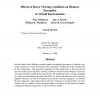Free Online Productivity Tools
i2Speak
i2Symbol
i2OCR
iTex2Img
iWeb2Print
iWeb2Shot
i2Type
iPdf2Split
iPdf2Merge
i2Bopomofo
i2Arabic
i2Style
i2Image
i2PDF
iLatex2Rtf
Sci2ools
PRESENCE
2008
2008
Effects of Stereo Viewing Conditions on Distance Perception in Virtual Environments
Several studies from different research groups investigating perception of absolute, egocentric distances in virtual environments have reported a compression of the intended size of the virtual space. One potential explanation for the compression is that inaccuracies and cue conflicts involving stereo viewing conditions in head-mounted displays result in an inaccurate absolute scaling of the virtual world. We manipulate stereo viewing conditions in a head-mounted display and show the effects of using both measured and fixed interpupilary distances, as well as bi-ocular and monocular viewing of graphics, on absolute distance judgments. Our results indicate that the limitations on the presentation of stereo imagery that are inherent in head-mounted displays are likely not the source of distance compression reported in previous virtual environment studies.
| Added | 14 Dec 2010 |
| Updated | 14 Dec 2010 |
| Type | Journal |
| Year | 2008 |
| Where | PRESENCE |
| Authors | Peter Willemsen, Amy Ashurst Gooch, William B. Thompson, Sarah H. Creem-Regehr |
Comments (0)

